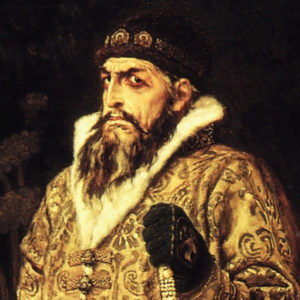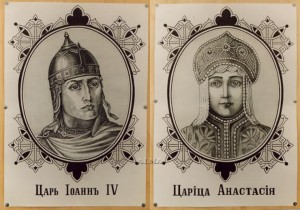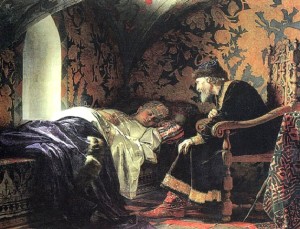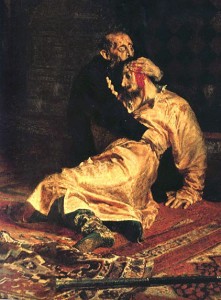By Katrina Kitchen (edited by Helen Azar)
Editor’s note: Dear reader, to get my “Romanov Family” website off to a good start, I plan to post a series of articles on Russian history leading up to – and of course including – the ascent of the Romanov family to the throne of Russia, which did not happen by accident. I would like to start with Ivan the Terrible (Ivan IV), because: a. He was a fascinating historical character, and b. Through his first marriage, the first member of the Romanov family came to the throne, or at least became a consort of the Tsar of Russia. This fact was undoubtedly taken into consideration later on, when the first Romanov Dynasty ruler, Mikhail Romanov was elected to be Tsar of all the Russias. So in a sense, Tsar Ivan the Terrible got the proverbial ball rolling for the Romanov Dynasty! Which is why I think he is important to the story of the Romanov family. I will eventually publish another article about Ivan, dealing with his seven wives. ~Helen~
Many thanks to Katrina Kitchen for this article!

Prince Ivan Vasilievich, the future Ivan the Terrible, was born on August 5,1530. Ivan was the first child and long awaited son of Grand Duke Vasily III of Muscovy (the official name of the Russian state at that time) and his second wife, Elena Glinskaya. Ivan became fatherless in 1533, and after his father’s death he became the Grand Duke of Muscovy at the age of three, with his mother Elena Glinskaya acting as regent.

Even though Elena became regent for her son, her power was continually challenged by the boyars, as the Russian nobility was known. When Elena suddenly died in 1538, most likely from poisoning, the regency alternated among several feuding boyar families fighting for control of Muscovy.
As a child and youth, Ivan customarily felt neglected, offended, and mistreated by the boyars. Whatever traumatic experiences the future Tsar Ivan the Terrible went through at the hands of these boyars obviously had a major effect on him. It is said that during his youth Ivan is reported to have exhibited numerous acts of extraordinary sadism, and already an inclination towards cruelty that was displayed later in his reign.
In 1547 the boyar rule ended when Ivan IV announced his intention of becoming Tsar. The head of the Russian Orthodox Church arranged an elaborate coronation for the seventeen year old Ivan which added the title Tsar (from the Roman imperial title Caesar) to the traditional title of Grand Duke. Ivan was the first Russian prince to take this title, which was intended to convey the exalted image of the ruler as the representative of God on earth.
Connection to the Romanov Family
Shortly after Ivan was crowned Tsar he married Anastasia Romanova, the first of his seven wives. Anastasia was a member of the noble Romanov family, the dynasty which later will go on to rule Russia. He is reported to have married her for love, and Anastasia Romanova is believed to have had a moderating influence on Ivan’s behavior. It was suspected that Anastasia’s death may have been carried out by one or more political factions at court. After her death, the first Tsar of Russia had set out on the road of becoming “Ivan the Terrible”.


Early reign
The early part of Ivan’s reign was one of peaceful reforms and modernization. The first printing press was introduced in Russia.
In the 1500’s the boyars’ corrupt system of provincial administration underwent major reform. Since the 1300’s, governors had been sent from Moscow, the seat of the Muscovite government, to govern the provinces. By not being held accountable to the territories they were assigned, these governors wrung money and food from the populace while providing little in the way of good government in return. Reform began in the 1490’s when local officials were appointed to oversee the rebuilding of Muscovy’s fortresses and then given other assignments. In the 1530’s local police officials were appointed to try to stamp out crime, which was rampant during the disorder of Ivan’s minority years.
The former boyars’ council was replaced by a “chosen council” consisting of members who owed their status to the czar. From 1547 to 1560 Ivan governed the land with their aid. During those years a number of reforms were instituted to bring back much needed stability to Muscovy after the utter chaos the boyars had made before Ivan was crowned. During Ivan’s early reign the Sudebnick, or the country’s law code, was expanded, revised, and widely used. An infantry corps, better known as the Streltsy, was created. Armed with long guns, the Streltsy increased the strength of the Muscovite army. Ivan subordinated the Russian Orthodox Church to the state, making a system of rituals and regulations.
In 1552 Moscow needed revenue to invade Kazan. Ivan embarked on a plan to sell what was left of provincial administration to the locals. This was so successful that the sale of provincial civil administration was completed in 1556 to raise funds for the Astrakhan campaign. The tsar’s treasury benefited, but the Russian people benefited also, as locally elected officials replaced the exploitative governors sent from Moscow.
After reorganizing the army, Ivan conquered Kazan in1552 and Astrakhan in 1556, thereby inaugurating Russia’s eastward expansion. He had Saint Basil’s Cathedral constructed in Moscow to commemorate the seizure of Kazan. Legend has it that Ivan was so impressed with the structure that he had the architects blinded, so that they could never design anything as beautiful again.
In 1566, Ivan summoned the first general council of the realm, the Zemsky Sobor, composed of representatives of different social ranks, including merchants and lower nobility. Ivan also began trade with England via the White Sea in the mid-1550’s.To improve his access to the Baltic Sea, he undertook a campaign against Livonia in 1558.The Livonian War (1558-1583) was the first big mistake of Ivan’s reign. After the annexation of the Volga, Moscovy had two alternatives for expansion. They could either conquer and annex the Crimean khanate which was constantly raiding Russia and Poland for slaves or reconquer Slavic lands to the west which had been annexed by Livonia, Lithuania, and Poland. Adopting a defensive posture towards the Crimea the Russians dove into an unsuccessful war against the Livonians on the western front that contributed to the widespread ruin in Russia. he war with Poland and Sweden, he was at first successful but was later defeated by Stephen Bathory, king of Poland and Lithuania. The peace treaties of 1582 and 1583 forced the czar to renounce his territorial gains and cede additional territory to Sweden.
Defeats in the Livonian War as well as the traumatic experiences of childhood aggravated Ivan’s precarious psychological condition. He had begun to show irrational suspicion of those around him when in 1553 he had a near fatal illness and the boyars refused to take an oath of allegiance to his infant son Dmitri. Recalling the feuds of Ivan’s minority years, the boyars preferred an adult successor. Ivan took their refusal as treason. When his beloved wife Anastasia died in 1560 Ivan believed she had been poisoned by the boyars’ and member of the Chosen Council in a plot to replace him on the throne with his cousin Vladimir of Staritsa. So he had the council members exiled. Setbacks in the Livonian War led to the defection of many military commanders who were fearful of the Tsar’s wrath.
Other negative aspects of this period in Ivan’s reign include the introduction of the first laws restricting the mobility of the peasants, which eventually led to serfdom in Russia.
Later Reign
The later half of Ivan’s reign, though far less successful, was to be one of the bloodiest times of Russian history. In December of 1564 Ivan left Moscow with some of his court under the guise of visiting various monasteries. The reality was that the paranoid Tsar, taking valuables and relatives with him, had abandoned the capital. Fearing chaos would reign in Moscovy without the Tsar, January of 1565 saw Ivan setting down his own terms for returning to the throne.
Ivan’s terms were that his perceived enemies were to be punished, and the state was to be split in two. The Oprichnina was to be Ivan’s personal domain under his absolute control. The Zemshchina would be ruled by a council of boyars. Ivan returned to the capital in February of 1565.
Since Oprichnina was the section of Russian directly ruled by Ivan, it makes sense that it be policed by his special corps of personal servicemen, notoriously known as the Oprichniki. With the help of the Oprichniki, he diminished the political influence of the boyars and forcibly confiscated their lands in a reign of terror. Many boyars were executed or exiled. The Oprichnina, which lasted from 1565 to 1572 and rivaled only by Joseph Stalin’s Great Purge of 1936-1938,was one of the most bizarre episodes in all of Russian history.
There were two main periods of the Oprichnina which reflected Ivan’s increasing paranoia. The first period, which lasted from 1565 to 1566,a large number of Princes were exiled to Kazan. All of their properties were confiscated and distributed to Ivan’s Oprichniki. Ivan allowed some of the Princes to return to their devastated estates in 1566.When Ivan convened the Zemsky Sobor later that year to advise the government on whether or not to continue the disastrous war with Livonia, a large number of delegates complained about the Oprichnina. These complaints turned out to be a fatal mistake.
The second and most lethal stage of the Oprichnina, which lasted from 1566 to 1571, was set into motion. Among those killed were the head of the church, Metropolitian Filipp Kolychev for criticizing the Oprichnina, and Prince Vladimir Staritsky who was chosen to replace Ivan if he had died from his illness in 1553.In 1570 the Oprichniki sacked Novgorod on Ivan’s orders. Between thirty and forty thousand were massacred. A great many of its citizens were murdered because it was believed individuals there had links to Ivan’s perceived enemies. All relatives and slaves of the victims were also murdered.
The Oprichniki soon got out of hand, turning into a band of murderous thugs. This second stage of the Oprichnina wreaked so much widespread havoc that the Crimean Tatars were able to sack Moscow in 1571.The area around Moscow depopulated thanks to the destruction of much of the land. In 1572 the Oprichniki were disbanded after their complete failure to defend Moscow from the invading Crimean Tatars.
This same year Ivan resumed rule over all of Muscovy. Sadly much of it was in ruins. The numerous tragedies of Ivan’s existence were not yet over. In 1581 Ivan censured and supposedly beat his pregnant daughter-in-law for appearing in immodest clothing, causing a miscarriage. His son Ivan Ivanovich, upon hearing of this, rose to defend his wife. Engaging in a heated argument with his father, Ivan Ivanovich was accidentally killed by the Tsar. The only respectable heir to Ivan’s throne was dead. Since the church only permitted three marriages, and recognized none of Ivan’s later wives, his son Dmitri was considered illegitimate because his mother was Ivan’s seventh wife. This left as heir Ivan’s feebleminded son Fyodor, who reigned from 1584-1598.Upon Ivan’s death, the now ravaged kingdom was left to his unfit and childless son Fyodor, who was the last Ryurik ruler in a long line that extended back seven centuries.

Death and Legacy
Two years after killing his son Ivan Ivanovich, Ivan died suddenly on March 18, 1584 in Moscow while playing chess. He is buried in the Kremlin. The apparent cause being he was probably the victim of a heart attack. Ivan’s tomb was opened during renovations in the 1960’s. A Soviet forensic examination discovered his remains contained high amounts of mercury that he may have taken as a medicine. Some say the mercury showed that Ivan was poisoned. Others think mercury was given as a treatment for syphilis which was a condition Ivan reportedly had. Either way no signs of foul play were discovered.
History shows Ivan the Terrible as a psychopathic tyrant. Maybe the events of his traumatic childhood caused him to behave and rule the way that he did. Any way you look at it Ivan left Russia an empire. With the annexation of the non-Russian lands in the Volga region and areas east of the Volga in the Urals, and the development of Siberia’s abundant natural resources, Russia would become a world power even though much of the old heartland was in shambles.
The remains of Russian society had changed dramatically during Ivan’s rule with the expansion of the service class. Many Princes along with other members of the elite had to answer to the Tsar and no longer rivaled him for power. Adding to this a new stage in history, so began the enslavement of the peasantry under Ivan’s rule.
4 thoughts on “IVAN IV (“IVAN THE TERRIBLE”): The First Tsar of Russia, and He Who Paved the Way for the Romanov Dynasty…”
Иван Грозный! Excellent. Great way to begin a beautiful website! Keep up the good work, Helen Azar!
Jim Wilhelm
Thanks Jim!
Helen Azar
detailed and short …keep up the good work
Il be looking forward to reading the next article ☺️
Dr Christopher L Hmarj
Thank you!
Helen Azar